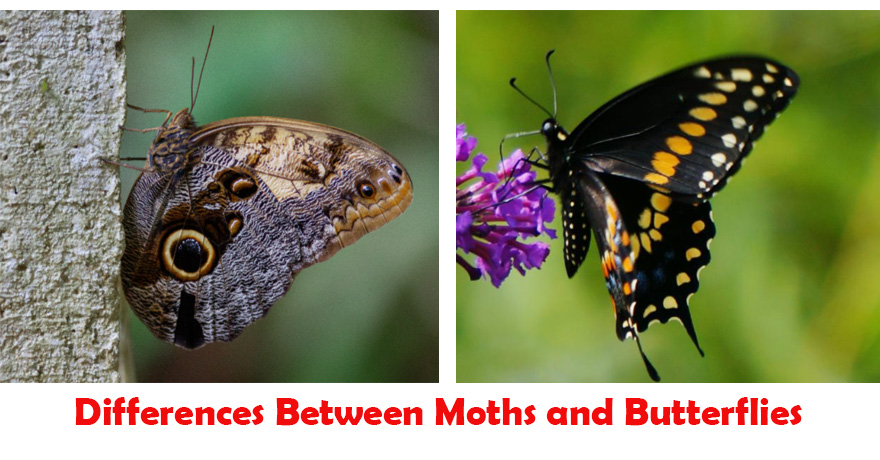11 Differences Between Moths and Butterflies
Not everyone can tell the difference between Moths and Butterflies if these swift tiny guys fly past us. A lot of people rely on the colors, but is this sign always correct in every situation?
Fortunately, we have compiled a comprehensive set of rules for you to navigate your way through nature much more easily!
What you will learn after reading this article:
- The prominent difference between a butterfly and a moth.
- 10 other differences to spot a moth or a butterfly.
How To Tell the Difference Between Moth and Butterfly?
Most scientists would agree that regarding Butterflies vs Moths, the most helpful sign for them to distinguish these two creatures is the shape and structure of the antennae, also known as the feelers.
Butterflies tend to have filamentous antennae, which are very slender with clubbed ends. Meanwhile, moths’ antennae are feathery, comb-like, or filamentous; and not clubbed at the ends.
There are a few exceptions to this rule: the African butterflies Pseudopontia paradoxa don’t have clubbed ends on their antennae, while several moth families such as Uraniidae, Castniidae, and Sematuridae have this signature.
To equip you with a better understanding of butterflies and moths, let’s move on to the other differences between them!
CÓ INFOGRAPHIC, TÌM TRONG FILE WORD
Love Butterflies, check more: Butterfly dresses & butterfly Hawaiian shirts
Visual Difference
We usually think moths are dull colors and butterflies are brighter. It is a good starting point to tell, though it is not always true!
Moths have hair on their bodies, while butterflies lack hair. Scientists believe the hair is a mechanism against the echolocation performed by bats.
You might want to look at the wings more carefully too, because you will find a device connecting the moth’s hindwings and forewings. It is called frenulum, and butterflies don’t have it.
Colors Of The Wings
Moth and Butterfly wings are drastically different most of the time, and non-professionals tend to decide if they have seen a moth by the dark and dull colors of the wings. The reason is associated with moths being nocturnal creatures.
On the other hand, butterfly wings are radiantly colored, almost as colorful as the flowers they feed off. These colors are crucial for mating within a species or warning against predators.
Moths and butterflies both have layers of proteins making up the structure of their wings, though butterfly wings usually have pigmented scales. The difference arises from these tiny scales reflecting light and sending various colors to our eyes.
Once again, exceptions exist. Moths fly during the day and look very bright in color, yet they are toxic. Some moths are both nocturnal and colorful at the same time.
Furthermore, not every butterfly species has multiple colors on their wings! You can take the Baron or the cabbage white butterflies for example. They are very plain-looking.
Check more: How Do Butterflies Mate?
Resting Posture
When moths and butterflies rest, they keep their wings in different manners. Specifically, moths often don’t close their wings while resting, but butterflies do.
Of course, some species behave against this rule!
You will find moths of lunar thorns and canary-shouldered thorns with a narrow-angle or a vertical direction for their wings, though butterflies might also not fold their wings while sleeping if they enjoy the warm weather.
Body Shape
Another easy way for you to spot the difference is by observing the body of each.
With moths, you will see a fuzzy surface on their bodies, which is a bit stocky compared to what butterfly bodies look like. Moth legs are also shorter.
This difference reflects their lifestyles quite well. With a more streamlined body, butterflies can fly more easily and speedily, and moths are usually known for being quite tardy.
Forelegs
Moths have fully developed forelegs while many butterflies (and skippers) have them reduced. You won’t find the terminal segments on a butterfly’s forelegs.
The original purpose of the forelegs was to walk. After being reduced, they can no longer perform that task as butterflies have no actual need for walking on a surface.
Eye Types
Despite the similarities between their compound eyes, moths have superposition eyes and butterflies have apposition eyes. The superposition eyes adapt to low light and the apposition eyes favor resolution, which benefits their respective lifestyles.
The exceptions that can be listed here are the diurnal moths with apposition eyes or the nocturnal butterflies with superposition eyes.
Activity Patterns
If you are only getting started with butterflies and moths, it is easy to assume that all butterflies are diurnal and all moths are nocturnal. However, we have quite a few diurnal moths, too.
Because moths being active at night is a result of them being attracted to lights, daylight might have certain effects on them. The number of moth species that can be active during the day is around 15 – 25%, which is not a small number at all!
- Diurnal Moths: Hummingbird Hawk, Cinnabar, White-lined Sphinx, Six-Spot Burnet, and Clearwing.
- Nocturnal Butterflies: Northern Pearly Eye, Chocolate Demon, Common Glider, and Malayan Night Fliers.
Habitat
The main food source for butterflies is flower nectar, so they naturally favor gardens and meadows with thriving plants and blooms. Regarding this aspect, moths can be found in more environments, hence you can find them in wetlands and forests too.
Both of them are cold-blooded and need heat to function. Nonetheless, butterflies rely on heat from their surroundings, while moths can gain more heat by vibrating their wings. It also explains why moths can be active at night.
Pupa
Butterflies and moths collide again with the metamorphosis to become grown individuals: eggs, larvae, pupae, and adults. However, caterpillars of butterflies have chrysalises for the pupae state, while moths go through it in a cocoon.
Chrysalises are hard with a smooth surface because they are made of protein, and you will mostly find them hanging from a leaf, a twig, or even your windowsill.
Cocoons are created with the same fibers of silk, so they are much softer than chrysalises. Rather than dangling from a surface, they can be put in many positions and directions.
Diversity
With how colorful butterflies are, we are easily under the impression that they have more species, yet they stop at a humble number of 17,500, while moth species go up to 160,000.
They both belong to the Lepidoptera family and have more species than birds, fishes, mammals, and reptiles altogether.
There is a surprising research result pointing out that butterflies have a closer connection to micro-moths rather than macro-moths. For a more in-depth look, we will perhaps need more discoveries.
The Takeaways
Now you have a lot more ways to distinguish between a moth and a butterfly, rather than looking at their antennae or their colors!
Isn’t it such a wonder that they are very similar and different at the same time?
Mother Nature is always full of mysteries, so if you have more tips to differentiate them or more stories about them, feel free to share them with our community!

